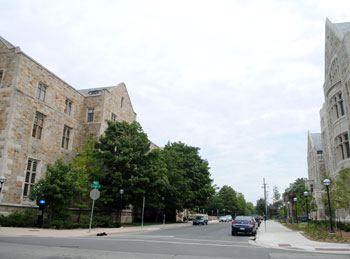This Wednesday Ann Arbor is in for a rare treat when Gordon Lightfoot – the fair-haired troubadour from north of the border whose repertoire includes such classics as “Early Mornin’ Rain,” “If You Could Read My Mind” and “The Wreck of the Edmund Fitzgerald” – makes his first local appearance in more than nine years, performing at the Michigan Theater.

Gordon Lightfoot in a recent publicity shot. He'll be performing at the Michigan Theater on Sept. 21, but has a decades-long history of touring here.
For his part, the 72-year-old singer-songwriter is glad to be returning. “I’m looking forward to it,” he says via telephone from his home in Toronto. “I’ve always gotten good vibes from Ann Arbor.”
Lightfoot first brought his guitar to town almost exactly 45 years ago, to play a three-night stint at a funky Episcopalian coffee house located in a former print shop at 330 Maynard Street. Today the unprepossessing brick building is home to Madras Masala, purveyor of exotic Indian delicacies; but in the ’60s it was Canterbury House, purveyor of coffee, donuts, and a hip spirituality that meshed nicely with the countercultural ethos of the day.
Canterbury House is actually a generic name used by many Episcopal student ministries at colleges across the nation. Ann Arbor’s incarnation was established in the mid-1940s and by the ’60s had become an important feature of the city’s increasingly progressive landscape. It began offering folk and blues music in 1965 as an experiment in reaching youth through the arts. Though mostly local performers were featured, the new program proved phenomenally successful, and the next year it was moved to a bigger location to bring in nationally-known acts.
First to appear at the extensively remodeled Maynard Street venue was the California-born “one-man folk festival,” Michael Cooney – “brandishing guitar, kazoo, banjo, autoharp, microphone, guitar strap, and truck,” according to the ad – who played three sold-out nights in early September.
Next up was a singer-songwriter from Ontario named Gordon Lightfoot, whose first album – the appropriately (if a bit over-exuberantly) titled “Lightfoot!” – had recently been released by United Artists. Although the young Canadian himself wasn’t that well-known in the states, his songs were. Marty Robbins took Lightfoot’s “Ribbon of Darkness” to the top of the country charts in 1965, and Peter, Paul and Mary made a Top 40 hit out of “For Lovin’ Me” that same year.
“If I had not gotten my songs recorded by some other artists very early on,” says Lightfoot, “I wouldn’t be talking to you right now. It was my songwriting, actually, that got me started.”
Which according to Herb David, proprietor of the famous guitar studio that bears his name, made Lightfoot very similar to another famous troubadour of that era, Bob Dylan. [Full Story]






